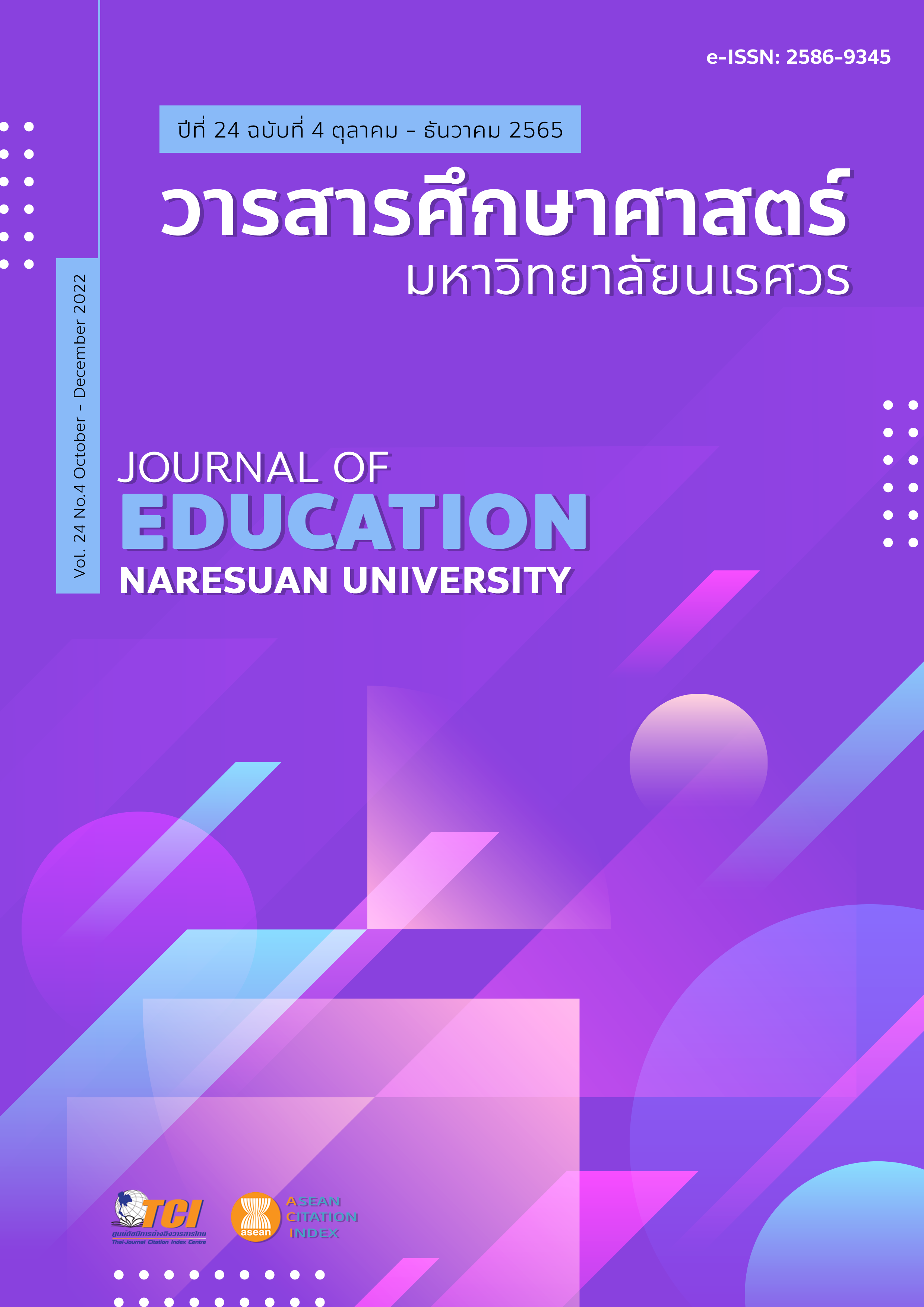THE STUDY OF GEOMETRIC REASONING ABILITIES OF MATHAYOMSUKSA TWO STUDENTS ON PARALLEL LINES BY USING ACTIVITIES THAT PROMOTE GEOMETRIC THINKING การศึกษาความสามารถในการให้เหตุผลทางเรขาคณิต เรื่อง เส้นขนาน ของนักเรียนชั้นมัธยมศึกษาปีที่ 2 โดยใช้กิจกรรมการเรียนรู้ที่ส่งเสริมการคิดทางเรขาคณิต
Main Article Content
Abstract
The purpose of this research was to study the geometric reasoning abilities on parallel lines by using activities that promote geometric thinking. The participants were 38 Mathayomsuksa two students of a large school in Bangkok. The research instruments used in the study consisted of 13 lesson plans using activities that promote geometric thinking and the geometric reasoning abilities test based on geometric thinking level of Van Hiele (1957). Data from the test were analyzed by using descriptive statistic and content analysis to conclude students’ geometric reasoning abilities during and after learning through the activities. The results of the study revealed that the students developed their geometric reasoning abilities during learning in all three levels, that are Analysis level, Informal deduction level and Formal deduction level. The students’ geometric reasoning abilities developed better when they gain more experience in writing the reasons. In addition, students’ score of geometric reasoning abilities in the test after learning were higher than 60 percent of total score. Most of them had well geometric reasoning abilities in Analysis level and Formal deduction level. However, they still need to practice at Informal deduction level due to they cannot give correct and complete reason for selected properties and theorems.
Article Details

This work is licensed under a Creative Commons Attribution-NonCommercial-NoDerivatives 4.0 International License.
The owner of the article does not copy or violate any of its copyright. If any copyright infringement occurs or prosecution, in any case, the Editorial Board is not involved in all the rights to the owner of the article to be performed.
References
Chutkaew, C. (2006). A development of geometric units and levels of geometric thought based on the Van Hiele Model by using dynamic geometry software for mathayomsuksa II students (Doctoral dissertation). Bangkok: Kasetsart University. [in Thai]
Damsuwarn, W. (2015). Concepts and research on mathematics understanding. Bangkok: Danex Intercorporation. [in Thai]
Jaidech, A. (2012). Developing geometric thinking on Pythagorean theorem of mathayomsuksa 2 students by using the Van Hiele teaching approach (Master thesis). Chiang Mai: Chiang Mai University. [in Thai]
Keawwandee, C. (2016). Promoting geometry proof ability on parallel lines of grade 8 students by using the Van Hiele teaching approach and the geometer’s sketchpad program (Master thesis). Chiang Mai: Chiang Mai University. [in Thai]
Khemmani, T. (2008). Science of teaching pedagogy: Body of knowledge for learning management with performance (7th ed.). Bangkok: Chulalongkorn University Press. [in Thai]
Makanong, A. (2010). Mathematical skills and processes: Development for evolution. Bangkok: Chulalongkorn University Press. [in Thai]
Makanong, A. (2014). Mathematics for high school teachers. Bangkok: Faculty of Education, Chulalongkorn University. [in Thai]
Ministry of Education. (2017). Indicators and Core Strands Learning of Mathematics (Revised version B.E. 2560) by Basic Education Core Curriculum B.E. 2551. Bangkok: The Agricultural Co-operative Federation of Thailand. [in Thai]
Namchittrong, N. (2003). The comparison of students’ geometric achievement between teaching emphatic the Van Hiele Model and traditional method (Master thesis). Bangkok: Kasetsart University. [in Thai]
Pawangkanan, S. (2016). The study of mathematics learning achievement of mathayomsuksa two students on “parallel lines” by using the Van Hele phases of learning in instructional activities at Triamudomsuksanomklao School, Bangkok (Master thesis). Bangkok: Kasetsart University. [in Thai]
Phromniwas, Y. (2010). Effects of organizing learning activities using the Van Hiele model on mathematics learning achievement and geometric reasoning ability of eighth grade students (Master thesis). Bangkok: Chulalongkorn University. [in Thai]
Pipithkul, Y. (2002). Teaching and learning mathematics in education reform era. Bangkok: Bophit Printing. [in Thai]
Ruksachol, O. (2009). Learning activities management on “the relationship between two dimension and three dimension geometric figures” by using emphasize learning activities on mathematics skill and process for mathayomsuksa one students at Watsamukkayaram School, Changwat Nakorn Si Thammarat (Master thesis). Bangkok: Kasetsart University. [in Thai]
Sutthirat, C. (2018). 80 innovations for learning management on child centered learning. Bangkok: P Balans Design and Printing. [in Thai]
Tangsa-nguantham, A. (2017). Developing instructional model in geometric proof for mathayomsuksa three students (Master thesis). Bangkok: Kasetsart University. [in Thai]
The Institute for the Promotion of Teaching Science and Technology. (2019). Teacher manual for basic math courses Vol. 2 by indicators and core strands learning of mathematics (revised version B.E. 2560) by Basic Education Core Curriculum B.E. 2551. Retrieved November 16, 2019, from www.scimath.org/e-books/10546/flippingbook/16/index.html
Thipkong, S. (1989). Van Hiele Model: Sequence of steps to learn geometry. Kasetsart Educational Review, 5(3), 91 – 99. [in Thai]


